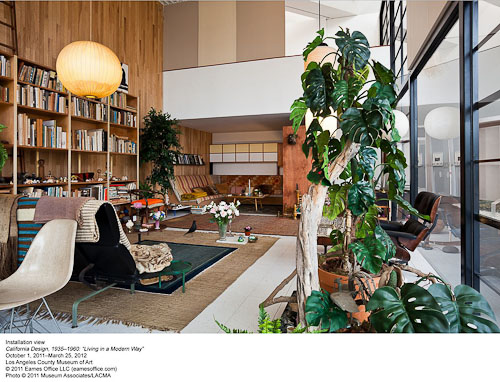California Mods inspire material study in Los Angeles

Last weekend I visited Los Angeles for a few days and inhaled the basin's modernist revival vibe. From the tchotchkes at OK to the ceramic tiles at Heath, it's a great place to bop and shop.
Then, egged on by Los Angeles Times Magazine design and culture guru Mayer Rus, we headed off to Los Angeles County Museum of Art (LACMA) and their fantastic Resnick Pavilion -- Renzo Piano's best kunsthalle ever -- to see "California Design, 1930-1965: Living in a Modern Way." (It's part of the uber-event Pacific Standard Time, which links 30 exhibitions across Southern California on the same time period.)

Packed with maybe 350 works of furniture, household items, textiles, surfboards and stereos, the show even has a Studebaker Avanti and a full-scale replica of the Eames House, the 1949 steel-framed Mondrianesque box in Pacific Palisades. The exhibition opens with a big shiny Airstream, Inc. camper trailer, and then snakes along a delightful path crafted by architects Craig Hodgetts and Ming Fung.
(Next week you can deep-dive into the show with a public panel led by Dwell's Frances Anderton and two-day symposium.)
Big names, but what about materials?
Many of the featured architects and designers are household names. Besides Charles and Ray Eames, we witness works by Richard Neutra and Rudolph Schindler through the lens of photographer Julius Shulman. Those talents, along with Millard Sheets, Alvin Lustig, J.R. Davidson and others, created the “distinctly regional version of residential modernism both in and around Los Angeles and in the Bay Area,” as Christopher Hawthorne wrote in the L.A. Times. (But this is really an L.A.-only show, in my eyes.)
"California Modern" is excellent, but for the Astute Architect the curators gave short shrift to the materials and manufacturers who made the whole regional design-boom happen.
By 1945 California had already proven it would dominate defense and aerospace production, and related industries were busting out at a speedy clip. New materials were mutating the design and manufacture of architectural and interiors products, from fiberglass and molded plywood to wire mesh and synthetic resins.
As is still the case, the aerospace industry's peacetime dividends were first seen in sports products and then furnishings. Colorful and resilient, Formica high-pressure laminates made possible Greta Magnusson Grossman's 1952 classic desk and storage unit, alongside local walnut and propped up on iron leg rods.
The classic ESU (Eames Storage Unit) and the DCW (Dining Chair Wood), both by Ray and Charles Eames and debuted around 1949, put Herman Miller square in the middle of California design innovation. The ESU was all about industrial production, using modularity and high-tech methods before anyone had heard the terms. Their machine aesthetic was paired with Japanese influences, using materials such as punched steel and wire cross-braces.
Dining Chair Wood is all about molded plywood, which had been perfected for sturdy wartime applications in airplane wings and submarine parts. In fact, Charles Eames had been trained making molded plywood splints for the U.S. Air Force.
Inside the big house
Other manufacturers that made California Modern happen included Evans Products Company of Portland, which made those Eames leg splints, as well as lamp-maker Ralph O. Smith Manufacturing and business equipment fabricator Burroughs Manufacturing Corporation, which made novel plastic products like a pitcher in the exhibition and still operates today out of Plymouth, Michigan.
By 1959 plastics were the American dream, and a Barbie doll made that year and sold for $3 is shown in the exhibit, for bad and for worse. (Mattel Inc. is an underwriter of California Design, 1930–1965.) Sure, it brings in the crowds, but it's a turnoff for design purists.
The highlight of the show is the reproduced Eames house and living room. A show across town at the A+D Architecture and Design Museum called "Eames Designs: The Guest-Host Relationship," was inspired by a Charles quote that inspires us all: "The role of the designer is that of a very good, thoughtful host, all of whose energy goes into trying to anticipate the needs of his guests."
Presenting the first major study of California midcentury modern design, LACMA is indeed a thoughtful host.
This post was originally published on Smartplanet.com